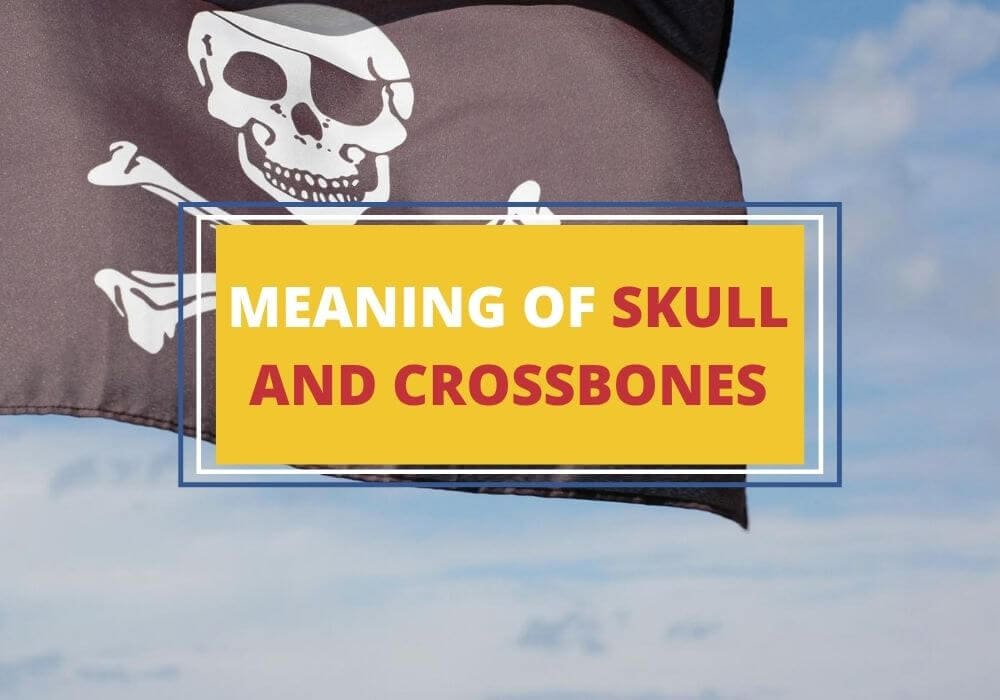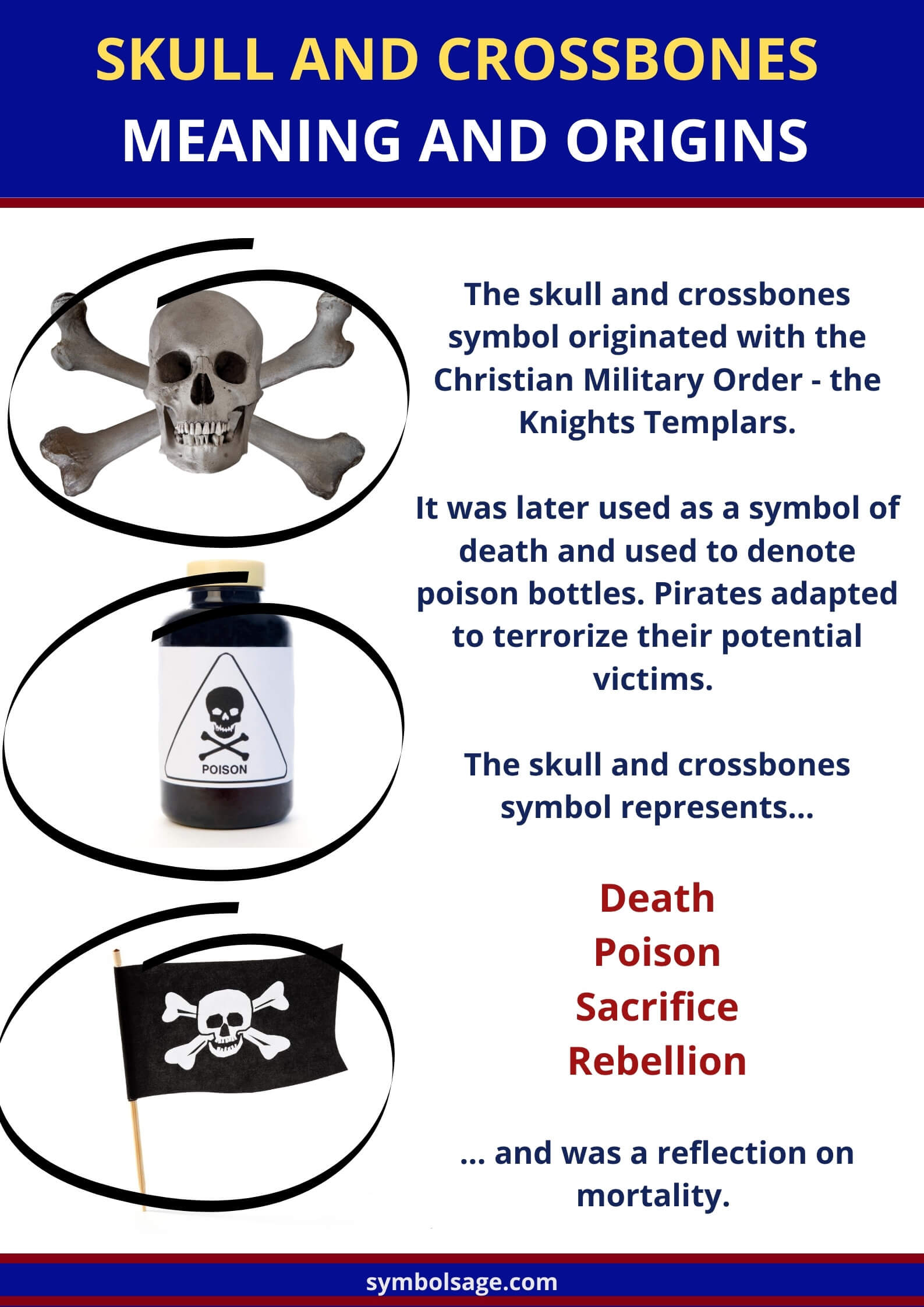
Table of Contents
From pirates to poison bottles, the symbol depicting a human skull above two crossed bones is commonly associated with danger and death. Here’s a look at the history and significance of the macabre symbol, and how it has been used by different cultures and organizations to represent various ideals.
History of Skull and Crossbones
We tend to associate the skull and crossbones with pirates, but the symbol has a surprising origin. It began with the Christian military order – the Knights Templars.
- The Knights Templar
The Knights Templar was a Christian military order that carried out important missions, and protected the pilgrims visiting the sites in the Holy Land. During the Middle Ages, the Templars were famous across Europe. They’ve been credited with the creation of the skull and crossbones symbol.
In an effort to seize their riches, the group was tortured into confessions and executed. Jacques de Molay, the order’s grand master, was burned alive. Only his skull and femurs were found. The Templars had the world’s biggest naval fleet in the 13th century, and many believe they used the symbol of the skull and crossbones on their flags in honor of their master.
Another legend connected to the templars tells a different story. In a macabre legend, Skull of Sidon, the true love of Templar knight died when she was young. He attempted to dig her grave, but a voice told him to return in nine months for he would have a son. When he returned and dug the grave, he found a skull rested on the skeleton’s femurs. He took the relics with him and it served as the giver of good things. He was able to defeat his enemies, using the image of the skull and crossbones on his flags.
- A Memento Mori on Tombstones
During the 14th century, the skull and crossbones symbol was used as marks on entrances to Spanish cemeteries and tombstones. In fact, it became a form of memento mori (a Latin phrase that means remember death) or figures that were used to remember the dead and remind people of the fragility of their lives. This practice led to the symbol being associated with death.
In the 16th and 17th centuries, the motif appeared on memento mori jewelry from lockets to brooches and mourning rings. Eventually, the symbol was used not only on gravestones but also on bone churches of Europe, as well as during various celebrations including Día de Los Muertos and Sugar Skulls of Mexico, where skull and crossbones are depicted in colorful decorative styles.
- The Jolly Roger and Pirates

During the early 1700s, the symbol was adopted by pirates as their ship’s flag as part of their terror tactics. Skull and crossbones signified death, which made it recognizable across the Caribbean and European waters.
While it isn’t clear why the flag was named the Jolly Roger, it is believed that the color of the flag would signify whether the pirates would spare lives or not. They originally used a plain red flag as a warning that they would give no quarter, but also began to use a black flag with a white skull-and-crossbones symbol to signal that they would show clemency in some cases.
Some pirates even customized their flags with other macabre motifs such as daggers, skeletons, hourglass, or spears, so their enemies would know who they were.
Meaning and Symbolism of Skull and Crossbones

Various cultures, secret societies, and military organizations have used the symbol on their badges and logos. Here are some of the meanings associated with the skull and crossbones:
- A Symbol of Danger and Death – Due to the macabre origins of the symbol, it became associated with death. In 1800s, it was adopted as an official symbol to identify poisonous substances, and first appeared on poison bottles in 1850.
- A Symbol of Sacrifice – When used as an emblem in military uniforms, it denotes that one would always be willing to put their life at stake for the country or a greater purpose. In fact, the Totenkopf, a German word for death’s head, was represented in Nazi SS insignia.
- A Depiction of “Death or Glory” – By the mid-1700s, the symbol was regarded as respectable enough to be chosen as a British regimental emblem. The Royal Lancers are trained to fight enemies. Wearing the skull and crossbones badge represents its motto of “death or glory” in protecting their nation and its dependent territories.
- A Reflection on Mortality – In Masonic association, it reveals the mysteries pertaining to Masonic beliefs. As a symbol, it acknowledges the natural fear of death that they have, just like any human, but motivates them to accomplish their work and duty as Masons. In fact, the symbol can be seen at Masonic lodges in Chambers of Reflection, as well as in their initiation rituals and jewelry.
- Rebellion and Independence – In recent times, the symbol has come to represent rebellion, breaking out of the mold and being independent.

Skull and Crossbones in Modern Times
Apart from hazardous substances and coat of arms, the macabre symbol can also be seen in tattoos, home decorations, and various fashion items such as biker jackets, graphic tees, bandana scarves, leggings, handbags, key chains, and gothic-inspired pieces.
Some jewelry pieces feature skull and crossbones in silver or gold, while others are decorated with gemstones, studs, or spikes. Nowadays, it is even embraced as an emblem of rebellion and creative expression in music, including heavy metal, punk, and rap.
In Brief
The skull and crossbones symbol has been associated with death but is also used by some cultures and organizations to represent various positive symbolism. The famous motif is now regarded as hip and trendy in tattoo, fashion, and jewelry designs, as a symbol of rebellion and independence.








